Yikes! We got our drug education from DARE (at Courreges Elementary), who did a decent job of educating without too much propaganda. Do you remember seeing Dianetics…
Dianetics junior much better then Krishna,
Dianetics junior much better indeed,
And all you people there, your tremendous,
Except the people in the middle,
When you’re toking up a big ass bowl of weed,with me, and KG
All Right! Oh Yeah! All Right! Oh my god!
Would all the ladies in the house say Yeah! (Yeah)
C’mon, all you motherfuckers say a prayer! (prayer)
Cause when you fight, you gotsta fight fair!
You mother fucker, huh? You mother fucker,
You know what time it is?
It’s Tenacious D time you motherfucker blow!
Fuck yeah!
Yeah! Yeah! Yeah!
Dude, that was TNT…
(Tenacious D rules!)
…commercials on during Saturday morning cartoon breaks? The volcano spouting lava looked so cool, and the persuasive voice oozing the words “It will change your life forever!” almost made me want to read the book (I can’t believe I can still remember this! is it a testament to their skills of persuasion?)! Good thing I was only 5 years old, and had to depend on my parents to read anything harder than Dr. Seuss out loud to me.
Keep it together, Kit… Keep it together! More info on Mindhead.
Welcome to Mindhead
Higothai

This is the Higothai flower, the flower of Ubuyama village. As some of you may know I used to hate bees. They used to sting me quite often. even though I avoided them, they would regularly land on me and jab me with their stingers. One time, I had to take a Tae Kwon Do orange belt test even though I had been stung on the sole of my foot- I passed, but it hurt like hell. I have since overcome my fear, and so I was able to get really close to this one.
Guardians of the 442 Gosen
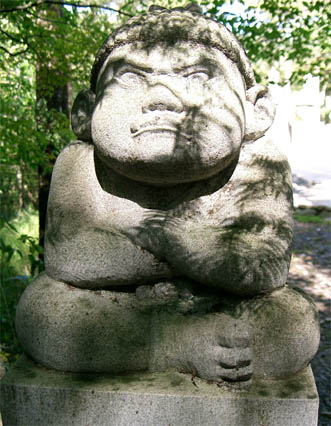
This one looks like the golden idol that Indiana Jones steals in the beginning of Raiders of the Lost Ark. It looks like he’s not happy about something.
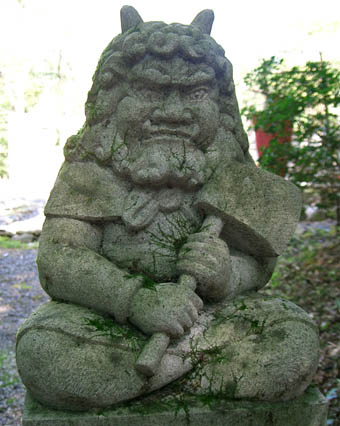
Something tells me that that isn’t a hatchet used for chopping wood. Dude looks ready for battle.
Ode To Inaka Ninniku
On a routine after-work drive, deep in the country I spotted an unattended shack with a sign that read “yasai (vegetables), 100 yen”. Nestled among the daikon and shiitake mushrooms was a mesh bag containing two choice clusters of garlic. For some reason, the garlic caught my eye, and so I dropped my 100 yen coin into the rusted steel tea cannister (tink!) and drove away satisfied with my transaction.
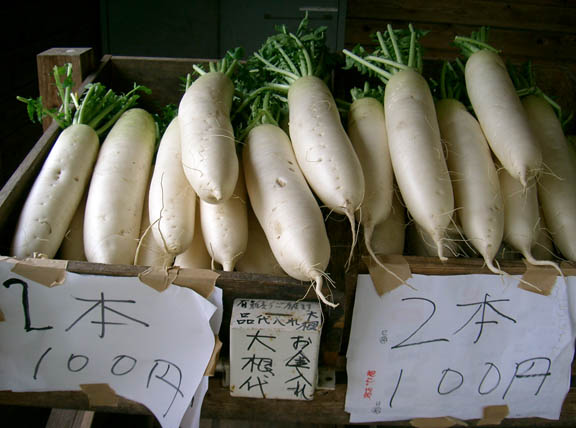
This is the setup I’m talking about. These daikon (giant Japanese radish) are not only ridiculously cheap, but are also fresher than anything you will ever find in Jusco.
Where else in the world can you find high quality produce by the side of the road and buy it based on the honor system? If this was Orange County, or even Kumamoto City, the cash box would be stolen at the very least and the vegetables would be thrown at the passing traffic! When theft does occur out here it is a big deal like it should be, and the cops come out and spend much time and effort trying to do everything they can to help. Out here is one place where I don’t harbor negative feelings about the police. It is in their best interest, as part of a tightly woven community of country folk, to do their best job and to be friendly. I understand why cops back home can be (and sometimes have to be) such assholes, but as a result I tend not to like them. It still makes me laugh when I remember going to Baja Fresh with Justin, hearing the worker ask the police officer “would you like beef or pig?” tacos.
Enough on cops, lets get back to garlic. This garlic that I bought was special. It was about the same price as garlic in the supermarket, but it was much superior. One thing that you can count on about country grown produce is that the farmers plant very good varieties because they are eating what they produce. Producing one’s own food is such a foreign concept for many people living in places like the U.S. or in big cities, as we are all disconnected from where it comes from and how it is made. My neighbors grow all of their own rice, vegetables, and in some cases chicken, eggs, and meat that they need, and surplus. It is this surplus that they give to their friends, barter, or sell in the booths. So the garlic that I bought from the stall is the same variety that some country family is enjoying as well.
What strikes me about this garlic is that it is so powerful. When I chop up onions nowadays, it is rare for my eyes to water from the fumes. However, when I mince my garlic up into tiny cubes, my eyes sting and well up, despite me wearing glasses. It hurts, but I know that the pain is worth it. The flavor of the garlic is rich and strong and full bodied, but not in an overpoweringly stinky way. Maybe it’s just a placebo, but I feel more healthy after consuming it. One more special thing about this garlic is that the skin peels away from the cloves without any fuss. Whoever developed this particular cultivar of garlic knew what they were doing, and did it well.
Talking about cultivars and heirloom species reminds me of listening to Professor David A. Cleveland from U.C.S.B. lecture about the effect of cultivated plants on society and the environment. Professor Cleveland regularly went all over the world deep into the countryside, where people had developed intimate relationships with the crops that they harvested, from Oaxaca, Mexico to Syria. He was quite passionate about the importance of preserving these cherished species not because he anthropomorphisized them in any way, but because these specific cultivars have very useful traits that have been engineered over thousands of years by farmers, specific to their locations and needs. Companies like Monsanto and other biotech firms go into the countryside and get samples of these plants, often giving nothing back to the farmers in return and exploiting this resource, making a huge profit. Why is this a big deal? Because the farmers in these areas are getting doubly screwed. It is because of the farmers and their ancestors that these strains exist, and it has taken them great time and effort to develop and maintain these. The cultivars and their DNA are rightfully the intelectual property of the farmers who developed them. In addition, these big companies sell the bioengineered strains to these farmers, driving many to develop a dependence on them. This leads many farmers to abandon the very crops that the engineered strains might have been developed from, since they tend to be high yield varieties that in the short term out perform the local crops.
The local cultivars are there for a good reason. They are ideally suited to that specific environment and that specific microclimate, and have allowed farmers to produce the maximum yield sustanably over an indefinite period of time. The strain of corn in one village might be completely different from the strain used the next village over due to subtle, yet important differences in hydrology, geology, temperature, or any number of variables.
With the adoption of commercial, all purpose seed, these cultivars are being lost. Unique, valuable genetic sequences that took countless generations to create vanish, all for the pursuit of maximizing profits in the short term (and creating a dependence based on petro-chemicals, depleting the soil, and creating other environmental and socioeconomic problems in the long run). One of the most tragic things about monoculture using the same seed is that it takes away the variety from food. Instead of countless choices, it all becomes the same. I find this loss of flavor, texture, and uniqueness to be truly disturbing.
Luckily, the fields in my neck of the woods are small, ununiform, and terraced. The farmers grow an assortment of different crops, and the people value their favorite strains of vegetables, fruits, and mushrooms. I mean, the farmers do depend on petro-chemicals to raise their crops and produce rice and other products for the mass market, but they also grow the old strains for their personal consumption. I am pretty sure that the future of the wonderful garlic that I ate will be safe in the hands of these country farmers, deep in the heart of Kyushu.
Unorthodox Wu-Shu
If a modern day Bruce steps forward to take up the challenge, a remake of Enter The Dragon is entirely possible with the help of Donald Rumsfeld (Thanks to Chris for the link) who will be cast as Han, the evil geriatric dude who makes life as a hand amputee look pretty cool with the interchangeable prosthetic hands of death. The part of Yang Sze (Bolo) is to be played by Bob Sapp, who claims “NFL” as his fighting style.
Not Too Shabby
Ultraman Attack
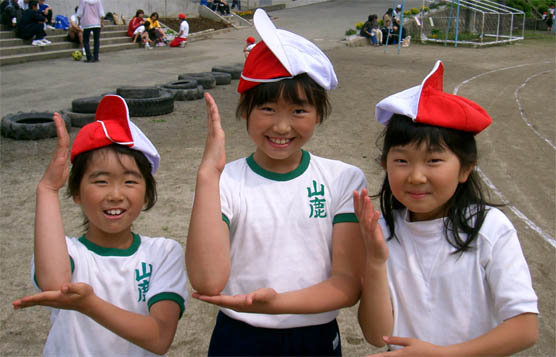
Makiko, Waka, and Sayuki prepare to whoop some ass.
Violent Crime in Japan
Is there a higher rate of violent crime and crime in general in the United States than there is in Japan? Yes, I think that’s a safe thing to say.
Japan is the model most often used by advocates of the prohibition of firearms. There is no private ownership of handguns, and among 120 million people there are only a little more than half a million privately owned long guns, including air rifles.
Japan’s annual homicide rate has been progressively decreasing for a decade and now stands at 1.2 per 100,000. It is reported that 97% of murders are solved – the highest clearance rate in the world.
Japan is one of the most disciplined nations on earth, with an authoritarian and conformist culture that precludes large scale law-breaking. There are few constraints on police powers, especially with respect to search and seizure. Rates of crimes not usually associated with firearms – rape, mugging and assault, are the lowest in the world and are trifling by European and North American standards. Japanese do not kill each other in large numbers because they are, in all respects, extremely law-abiding people. Interestingly, the current Japanese suicide rate of 21 per 100,000 is double the Canadian rate and almost double the rate in the United States. (this study is from 1992)
Japanese frequently and fervently insist that the U.S. is much more dangerous than Japan, but this is almost always based upon what they hear on the news and the movies that they see. I try to explain that only the most sensational news makes international headlines, and that aside from certain locations, the U.S. is a pretty safe place, and some people understand this.
However, the average Japanese violent crime is a hell of a lot more scary than the average violent crime in America. Although the amounts of crimes in which people shoot each other is really low in Japan, a lot of people are slicing and stabbing their victims over here. It makes sense. If there are no guns to kill people with, then you are left with knives. It takes a different kind of killer to weild an edged weapon and to stab and slash someone to death. In comparison, it’s pretty easy to kill with a gun. All you have to do is to aim and squeeze the trigger, and the bullet fills the gap between you and your target, driving itself into a body with its own momentum. If you stand far enough away, you won’t get any blood on you. With a knife, it’s always up close and personal and involves using muscle work and body movements to penetrate flesh (unless you are throwing it, but how many of us would throw a knife at someone we wanted to kill? if you miss, they could pick up the knife and stab you!). You are guarenteed to get blood on your hands. I imagine that killing up close leaves a greater impression on the murderer because it is an intimate act. The greater the physical distance from the victim, the greater the emotional distance can be.
Two days ago, a little girl in the sixth grade used a box cutter to murder a classmate at Okubo Elementary School (in Nagasaki-ken). Lets take a look at an article from the Daily Yomiuri (Thursday, June 3rd, 2004):
“I slashed at her after getting her to sit on a chair. I wanted to kill her,” police sources quoted the girl as saying.
According to Sasebo Police Station and the Sasebo Municipal Board of Education , the sixth-grade girl and Satomi Mitarai, the 12-year-old victim, liket to play with computers and frequently chatted with another friend on their own homepages.
The alleged perpetrator also was quoted as telling the police, “Because her (Satomi’s) attitude was cheeky, I called her (to a study room) and slashed her neck.
The police are investigating what Satomi wrote to the alleged assailant on the Internet and their conversations before the attack.
She killed her classmate because she was being flamed (teased in a chatroom)! And this wasn’t exactly a crime of passion. She planned it out, lured the girl into a room and had her sit down, clicked the box cutter blade out a few notches, and went for the neck! This evil act is so perverted, so unbelievable that it is hard to comprehend how someone, especially an 11 year old Japanese girl, could do it so casually. According to the article, she’s pretty calm about the whole situation and doesn’t seem to be exhibiting signs of remorse.
I remember my brother telling me about a case a few years back about a boy attending JHS in Kobe who cut off his friend’s head and stuck it on a pole in front of the school (mentioned in this article). Seems like a story out of Lord of the Flies, with something far more scary than a pig’s head impaled on a stick. So yes, the United States is a violent place compared to Japan, but I would argue that Japan’s brand of violence is, on average, committed by a much more emotionally disturbed individual, as most of the attacks in Japan are done with knives (another article from today reported that a cleaver and hammer were found next to the corpses of two Japanese men yesterday) and other close quater weapons.
Battle Royale doesn’t seem so much like fiction anymore.
Cynops pyrrhogaster
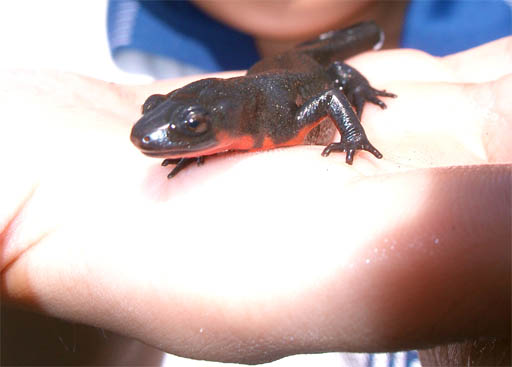
This is a Japanese Firebellied Newt that one of my students caught in the Tamarai River that runs next to my Chugakko. Yesterday, my JTE decided to have class outside, and to “wing it”. As would be expected when kids are taken outdoors and there is no lesson plan, the kids didn’t learn any English, but we had a great time playing in the river.
Thanks, I think…
Today, I walked in to the lunch room and heard the nursery school teachers mumbling my name. They collectively looked up, all of them wearing the same conspiratorial grin and called me a “Casablanca dandy”. Now what the hell does one make of that?


